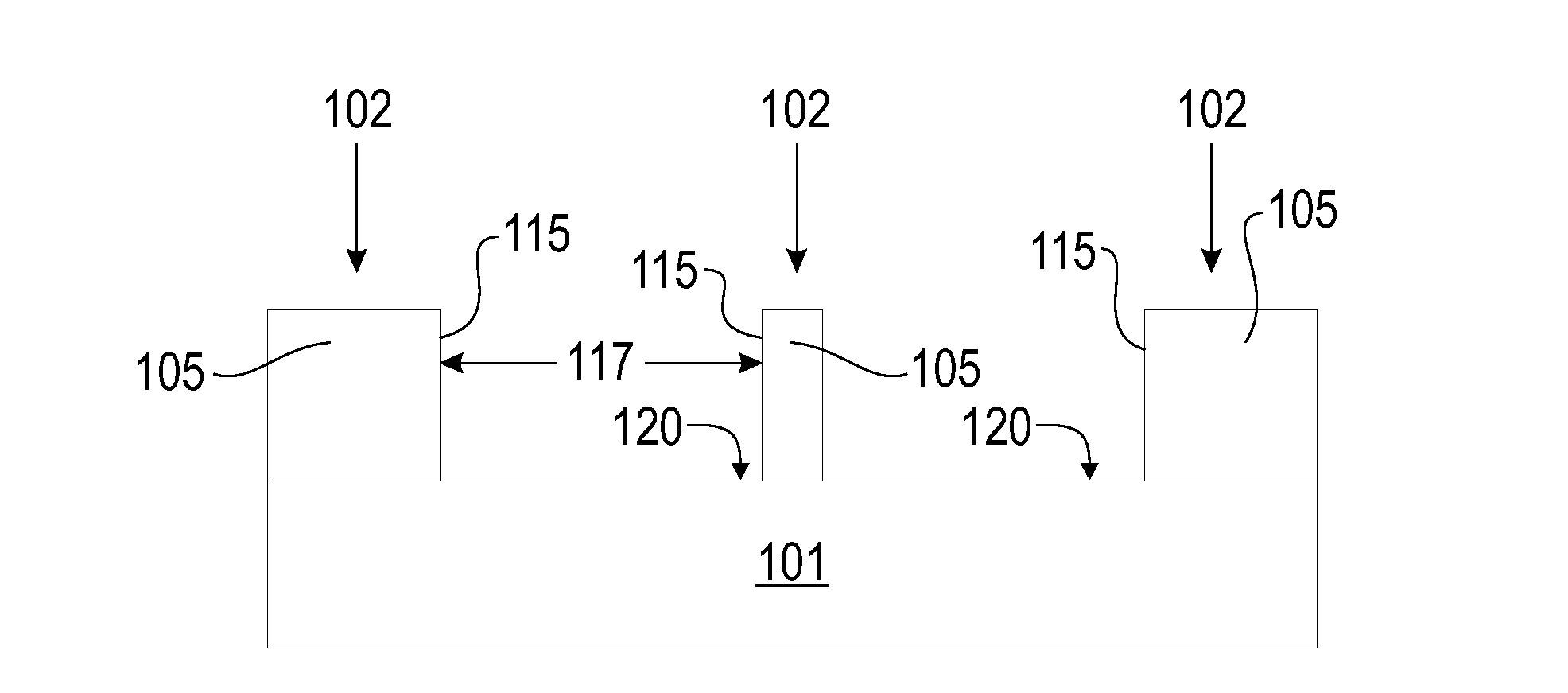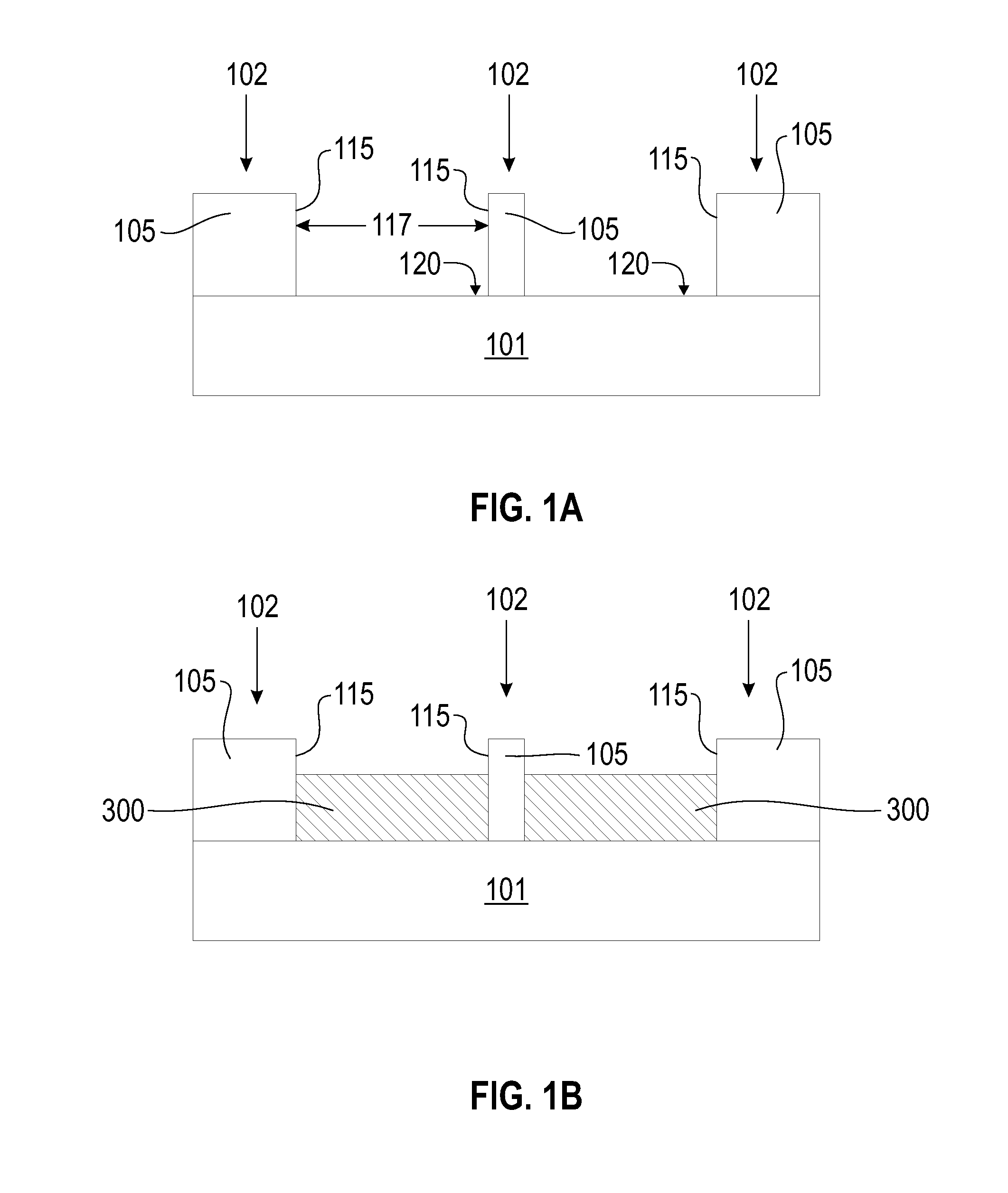Methods for aligning polymer films and related structures
a polymer film and related structure technology, applied in the direction of instruments, chemical/physical/physical-chemical processes, transportation and packaging, etc., can solve the problems of limiting the process window, requiring many deposition steps using expensive tools, and affecting the process
- Summary
- Abstract
- Description
- Claims
- Application Information
AI Technical Summary
Benefits of technology
Problems solved by technology
Method used
Image
Examples
example 1
[0074]A solution containing polystyrene (PS, 22 kilograms / more (kg / mole), from polymer source) and polymethylmethacrylate (PMMA, 21 kg / mole from polymer source) and polystyrene-block-polymethylmethacrylate (PS-b-PMMA, 38 kg / mole-36 kg / mole, from polymer source) with a PS:PMMA:PS-b-PMMA weight ratio of 6:3:1 was cast onto a silicon wafer substrate coated with an anti-reflective coating (ARC) with thermally hardened line / space positive photoresist features having a pitch of 240 nm and then baked at 200° C. for 1 minute. PMMA segregated to form lines next to the resist sidewall and PS segregated to the middle of the resist space. PS-b-PMMA resided in the interface between PS and PMMA lines and was used to tune the interfacial energy between PS and PMMA. The sample was etched in an oxygen plasma for 10 seconds to remove the PMMA and showed remaining PS and resist lines with pitch of 120 nm.
example 2
[0075]A polymer blend solution containing polystyrene (PS, 22 kg / mole, from polymer source) and polymethylmethacrylate (PMMA, 21 kg / mole from polymer source) and polystyrene-block-polymethylmethacrylate (PS-b-PMMA, 38 kg / mole-36 kg / mole, from polymer source) with a PS:PMMA:PS-b-PMMA weight ratio of 6:3:1 was cast on a substrate with negative e-beam resist (XR1541, hydrogen silsesquioxane from Dow Corning, hydrophilic resist) line / space features with a pitch of 110 nm and resist space from 50 nm to 80 nm. The sample was baked at 200° C. for 1 minute and etched under oxygen plasma for 10 sec. The remaining PS and resist lines demonstrated successful self-segregation in the narrower resist spaces.
example 3
[0076]A polymer blend solution of poly α-methyl-(4-hydroxyl benzyl) silsesquioxane-ran-α-methyl-benzyl silsesquioxane)) (poly(HMBS50-r-MBS50) and poly(1,1,1-trifluoro-2-(trifluoromethyl)-2-hydroxy-pent-4-yl methacrylate) (poly(iPrHFAMA) with weight ratio 1:1 was cast on a substrate with line / space and hole / post features of a standard 193 nm positive resist (AR 1682). The sample was baked at 200° C. for 1 minute, developed in 0.26 N tetramethylammonium hydroxide solution (CD26 developer) for one minute, then rinsed and dried. The poly(iPrHFAMA) was removed by CD26 developer, and poly(HMBS50-r-MBS50) was left forming lines in between the resist lines and forming dots in between resist dots.
PUM
| Property | Measurement | Unit |
|---|---|---|
| chemical affinity | aaaaa | aaaaa |
| dissolving | aaaaa | aaaaa |
| photosensitive | aaaaa | aaaaa |
Abstract
Description
Claims
Application Information
 Login to View More
Login to View More - R&D
- Intellectual Property
- Life Sciences
- Materials
- Tech Scout
- Unparalleled Data Quality
- Higher Quality Content
- 60% Fewer Hallucinations
Browse by: Latest US Patents, China's latest patents, Technical Efficacy Thesaurus, Application Domain, Technology Topic, Popular Technical Reports.
© 2025 PatSnap. All rights reserved.Legal|Privacy policy|Modern Slavery Act Transparency Statement|Sitemap|About US| Contact US: help@patsnap.com



